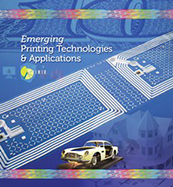Printing Trends | Emerging Technologies and Applications
- Published: May 02, 2014, By Jackie Bland
"Emerging Printing Technologies & Applications" Examined in New PRIMIR Research
PRIMIR’s latest study on “Emerging Printing Technologies & Applications” presents a stimulating overview of new technologies and applications and the applicability of these budding technologies for printers and printing industry suppliers. Conducted by Pivotal Resources, the research examines printed electronics and displays, 3D printing, and biomedical printing, as well as 2D bar codes and security printing; nanotechnology is also investigated.
Eac h of these emerging printing technologies is generating buzz in the industry, however, the PRIMIR study identifies which offer near-term opportunities for new revenue streams.
h of these emerging printing technologies is generating buzz in the industry, however, the PRIMIR study identifies which offer near-term opportunities for new revenue streams.
Security Printing
Security printing, although a longstanding industry specialty segment, is changing dramatically due to the increasing sophistication of criminals and heightened number of threats. Security printing, bar codes, 3D printing, and nanotechnology provide opportunities for printers to shield a brand owner from would-be imitators by implementing print techniques that are not easily duplicated. Recent technology advances for security printing have been in biometrics, unique inks, advanced substrates, and 2D bar coding.
“Biometrics,” referring to the identification of humans by individual characteristics or traits, is in use today. For example, in state-issued drivers’ licenses, a cardholder’s image and personal information is encrypted into a 2D bar code that appears on the license. When scanned, the code provides an image of the actual license holder for comparison to the person presenting the license.
Printed Electronics
In printed electronics, while commercial printing of complete circuits remains elusive, there has been some success in the laboratory and also pilot-scale operations. The first fully printed electronic products will likely be display backplanes, which will be combined with today’s printed (but not electronic) frontplanes to form a fully printed complete device. Firms that manufacture fluids (ink) formulations or new substrates will experience the most opportunity. According to the study, the printed electronics market may grow to approximately $20 billion within the next ten years.
3D Printing
Despite the groundswell of hype surrounding 3D printing, the report notes that production speed and cost currently limit commercial manufacturing. At an average build-up of one inch per hour and relatively high costs of $4 per cubic inch, 3D printing will remain in the hobbyist realm rather than traditional manufacturing for the foreseeable future.
3D printing does, however, represent an accessible opportunity for many printers, not in the application of traditional printing technology, but rather for expanding their offerings to customers since it is possible to buy equipment and supplies to enter 3D printing with minimal investment. Currently, according to the study, there is a great need for designers, operators, and salespeople who understand the value of 3D applications and can be trained with the solution selling and engineering skills required to promote and maximize this opportunity.
Nanotechnology
Although fairly new, this sector of the material manufacturing industry has already created a multibillion-dollar U.S. market. Nano matter is characterized by high-tensile strength, low weight, high electrical and thermal conductivity, and unique electronic properties. There is widespread interest in biology and biomedicine; computing and memory; electronics and displays; optoelectronic devices; optical components used in telecommunications; and, security applications.
 Of particular interest are graphene, carbon nanotubes, and quantum dots—each under intense research with new applications being unveiled regularly. Production, however, is one of the biggest challenges that nanotechnology faces. A key challenge will be health and safety concerns related to handling nano-materials. Barriers for scaling up production include securing investment dollars and providing proof of manufacturing consistency.
Of particular interest are graphene, carbon nanotubes, and quantum dots—each under intense research with new applications being unveiled regularly. Production, however, is one of the biggest challenges that nanotechnology faces. A key challenge will be health and safety concerns related to handling nano-materials. Barriers for scaling up production include securing investment dollars and providing proof of manufacturing consistency.
This new PRIMIR study, “Emerging Printing Technologies & Applications,” is currently available exclusively to PRIMIR Members. PRIMIR is a global source of data, analysis, and trend information about print and related communications industries. PRIMIR research is funded by member dues as well as through support from NPES The Association for Suppliers of Printing, Publishing and Converting Technologies. Learn more about PRIMIR at www.primir.org.











